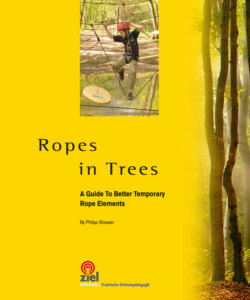Читать книгу Ropes in Trees - Philipp Strasser - Страница 9
На сайте Литреса книга снята с продажи.
ОглавлениеRedundancy, Zero Accident, and Other Safety Issues
The elements described in this book were selected and prepared to the best of our knowledge and common practices. The elements are basically set up to provide redundancy.
Redundancy means that all safety relevant features are backed-up. This is not limited to equipment and design, but especially when human error can cause accidents. Crosschecking and clear communication between two responsible persons is crucial for redundancy – e.g. when checking belays or hooking a participant – even if this aspect is not covered explicitly in this book.
To check if an element is set up with redundancy it is important to ask: “What would happen if this carabiner, rope, or branch breaks?” If the primary safety system fails, then the participant must still be able to return safely to the ground. The secondary safety system is not meant to preserve the element, but rather to secure the participant. Therefore, it is not necessary to employ two identical safety systems. Due to the possibility of an accident caused by human error, redundancy is an essential component to the design.
Occasionally, redundancy is limited or its aim is reduced. Chapters of this book with limited redundancy are clearly labeled and explained.
Conclusion
Apply redundancy whenever necessary and feasible to limit the need for extra measures.
Redundancy and continuous safety are very important. This book does not show consecutive elements where the participants have to switch their equipment from one element to another: in the worst case they have to unhook themselves and face mortal danger.
Redundancy and continuous safety are important for the “zero accident” concept. This term, coined by Walter Siebert, does not mean that there will never be any accidents. It means that no accident or situation must remain unconsidered.1 If the equipment, design, or methodology creates a hazard or causes accidents, then the link between the accident and method must be investigated. If there is a link, then this method must be improved or abandoned. If a potential hazard risk is discovered, it is important to inform others. This can be done in special internet forums or other public social networks.
Various course designers and operators develop their own designs and construction approaches and have acquired knowledge through experience. This information is generally not shared as it gives them an advantage over competitors. However, due to the importance of safety, it is a matter of ethics to publish accidents or other incidents and provide new developments to the open market.
